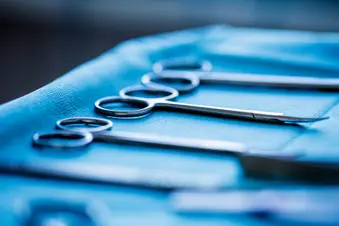
By Brittany Clayborne, as told to Sonya Collins
I was in perfect health at 26 years old in 2010 when I went into labor with my first child. I had him on a Sunday and I was home by Tuesday. But I went back to the hospital on Friday because I felt like I couldn’t breathe. The first hospital I went to told me that I was having a panic attack and to go back home. The second hospital told me I had had a heart attack at some point in the last week. That’s how I found out I had heart failure – peripartum cardiomyopathy.
Since then, technology has saved my life.
An Implanted Device Saved Me Six Times
The first piece of technology I had was an implantable pacemaker and defibrillator, which I got 2 years after my diagnosis when I started having dizzy spells and lightheadedness. My heart was struggling to keep up with its everyday duties.
Once it’s implanted, they give you what looks like an old-time answering machine that you connect to the Wi-Fi in your house. Every night before bed, and whenever you start to feel like you’re having a bad rhythm, you press a little button, and it starts recording your heart rhythm and sends the information to the doctor.
Even when I traveled, I had to take that little box with me so that it could download the information from my pacemaker and send it to the doctor every night.
Then the doctor can say, “Hey, you had a bad rhythm at 3:30 in the afternoon, what were you doing at that time?” If I tell him I was boxing, he might say, “Don’t box anymore.” The other benefit of this device was that whenever I had to go to the hospital, they already had all this information.
While I had that device – from 2012 to 2016 – I had a cardiac arrest and died, then was defibrillated back six times. That technology saved my life six times.
My Robot Heart Let Me Live Again
When I went to the hospital for the sixth time, they told me I needed a heart transplant. They said that if I waited in the hospital, I would get the heart sooner. I lived in the hospital for 9 months, but the new heart never came.
At this point, my son was growing up in a hospital room, coming to visit me there, celebrating birthdays and events there, and that wasn’t what I wanted for him. So I asked the doctors what else we could do, and they recommended an LVAD – a left ventricular assist device. It’s a pump they went in and attached to the left side of my heart. Then a wire came out of my stomach. It had to be plugged into batteries or a wall because the pump was battery-powered. If for some reason it was not plugged into batteries or into the wall, I would die.
It’s a major heart surgery. After that, your heart doesn’t pump. The machine does. So I didn’t have a pulse anymore. But my LVAD was finally pumping that 6 liters of blood per minute that my body needed when before it could only pump 2. My son called it my robot heart.
With the LVAD, I had to be extremely careful around water. I had to shower in a specific way. I couldn’t vacuum. I had to stay away from certain TVs that created a lot of static. I couldn’t do laundry or pump gas because of the static electricity.
But I can’t even explain the huge difference in my quality of life after getting the LVAD.
I went from just seeing my son for 30-minute visits in the hospital for 9 months to being able to tuck him into bed, attend his school events, and sit down and play Uno with him. If they had offered the LVAD to me 9 months earlier, I would have taken it rather than wait in the hospital for the heart, because that’s 9 months of playdates, birthday parties, and swimming lessons that I would not have missed. I don’t want another mother or father to miss that.
Finally, a New Heart
I had the LVAD from 2016 until January of 2018, when I got my heart transplant. They transported the heart from New Mexico here to Dallas, and I went into surgery that night, and my heart continues to do really well.
I am so grateful for all of this technology, and I am so grateful that it has given me the ability to live. We as a heart failure community need to embrace the advances and strides that are being made in science and tech that will allow us to live longer, better, healthier, and more fulfilling lives.
Show Sources
Photo Credit: Portra / Getty Images
SOURCE:
Brittany Clayborne, PsyD, chair, Patient Committee, Heart Failure Society of America, Ennis, TX.